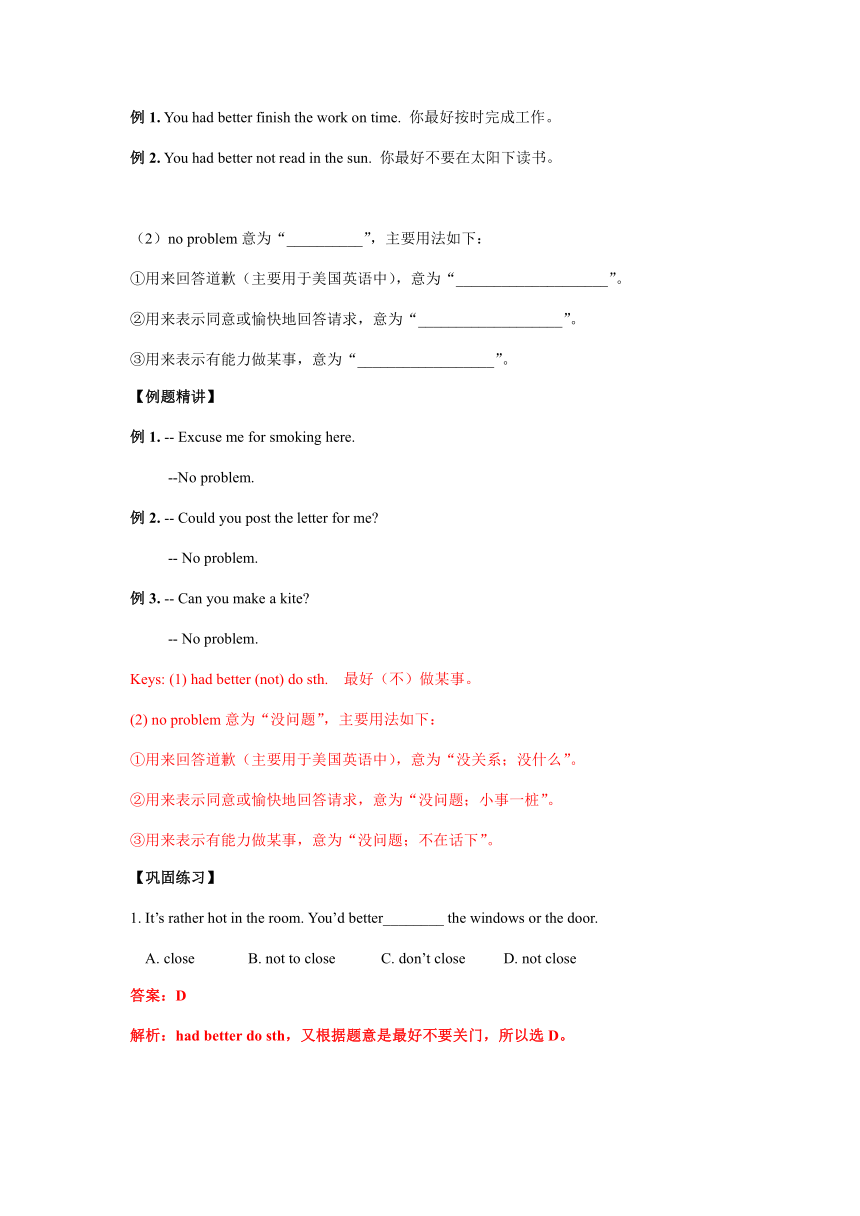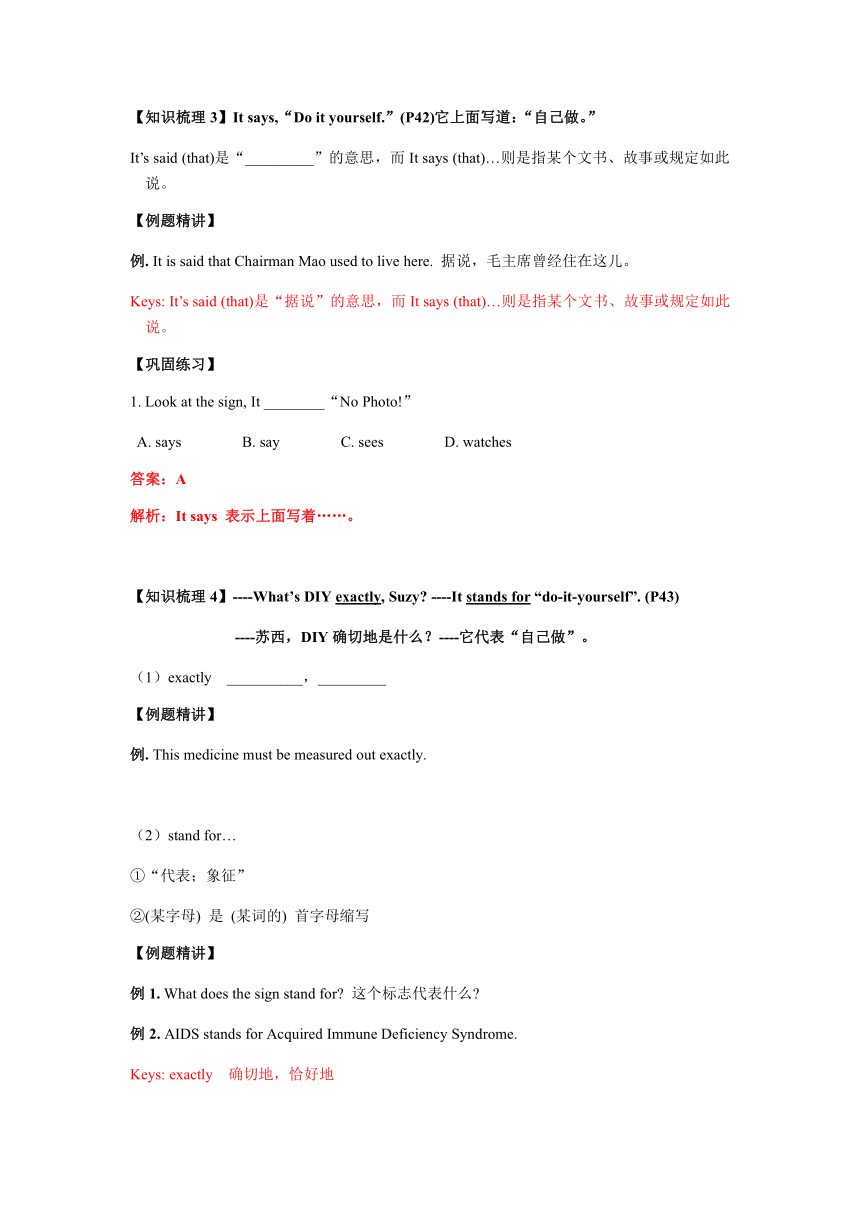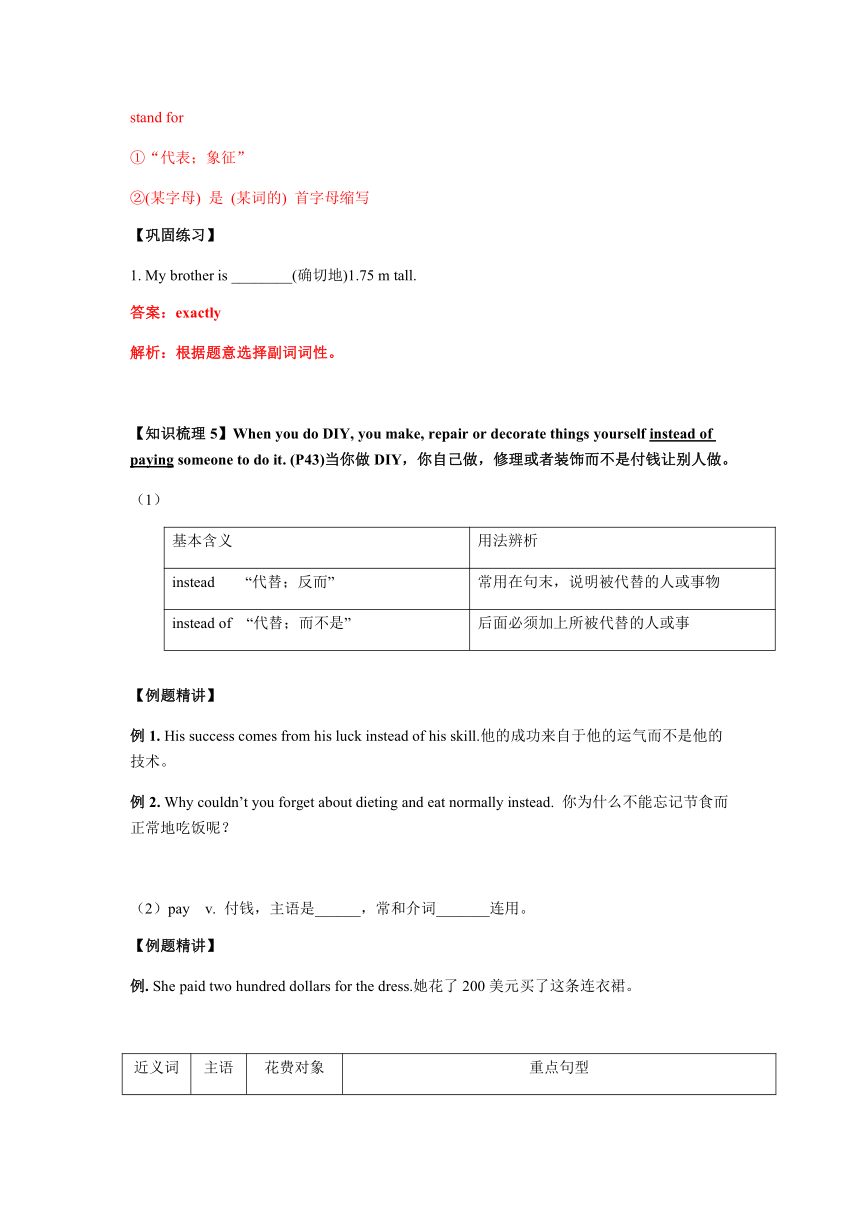8AUnit 4 Do it yourself 知识点讲义
文档属性
| 名称 | 8AUnit 4 Do it yourself 知识点讲义 |  | |
| 格式 | docx | ||
| 文件大小 | 27.7KB | ||
| 资源类型 | 教案 | ||
| 版本资源 | 牛津译林版 | ||
| 科目 | 英语 | ||
| 更新时间 | 2020-10-23 14:42:11 | ||
图片预览





文档简介
8A Unit 4 知识点讲义A(Comic~Reading)
【知识梳理1】All right. What’s next?(P42)好的。接下来怎么做?
All right. That’s right.和That’s all right.区别:
(1) All right.的用法如下:
①作对方______或______的应答语。
②作对方______或______的应答语。
【例题精讲】
例1. – Let’s go and ask him.
-- All right.
例2. --I think it is green.
-- All right.
(2)That’s right.是同意对方的观点或看法时的常用语,意思是“__________”。
【例题精讲】
例. -- Five and five is ten.
-- That’s right.
(3)That's all right.的用法如下:
①作对方_______的礼貌应答语。
②作对方_______的应答语。
【例题精讲】
例1. – I’m sorry, I can’t go there with you.
-- That’s all right.
例2. --Thank you very much for your help.
-- That’s all right.
Keys: All right. That’s right.和That’s all right.区别:
(1) All right.的用法如下:
①作对方建议或劝告的应答语。
②作对方想法或请求的应答语。
(2)That’s right.是同意对方的观点或看法时的常用语,意思是“对,正确”。
(3)That’s all right.的用法如下:
①作对方抱歉的礼貌应答语。
②作对方感谢的应答语。
【巩固练习】
1. ---Big animals can be a lot of trouble. Maybe you should get a small pet, like a goldfish.
---_______.
A. That’s all right B. That’s a good idea
C. You’re welcome D. Never mind
答案:B
解析:B 那是一个好主意,C 不客气,D没关系。
2. ---Would you mind if I open the window?
---________. I got a cold.
A. You’d better not B. Never mind
C. Of course not D. All right
答案:A
解析:根据后面的回答可知感冒了,不想开窗户,故应该是介意的所以选A。
【知识梳理2】--You’d better get some tools. --No problem. (P42)—你最好带一些工具。—没问题。
(1) had better (not) do sth. _________________。
【例题精讲】
例1. You had better finish the work on time. 你最好按时完成工作。
例2. You had better not read in the sun. 你最好不要在太阳下读书。
(2)no problem意为“__________”,主要用法如下:
①用来回答道歉(主要用于美国英语中),意为“____________________”。
②用来表示同意或愉快地回答请求,意为“___________________”。
③用来表示有能力做某事,意为“__________________”。
【例题精讲】
例1. -- Excuse me for smoking here.
--No problem.
例2. -- Could you post the letter for me?
-- No problem.
例3. -- Can you make a kite?
-- No problem.
Keys: (1) had better (not) do sth. 最好(不)做某事。
(2) no problem意为“没问题”,主要用法如下:
①用来回答道歉(主要用于美国英语中),意为“没关系;没什么”。
②用来表示同意或愉快地回答请求,意为“没问题;小事一桩”。
③用来表示有能力做某事,意为“没问题;不在话下”。
【巩固练习】
1. It’s rather hot in the room. You’d better________ the windows or the door.
A. close B. not to close C. don’t close D. not close
答案:D
解析:had better do sth,又根据题意是最好不要关门,所以选D。
【知识梳理3】It says,“Do it yourself.”(P42)它上面写道:“自己做。”
It’s said (that)是“_________”的意思,而It says (that)…则是指某个文书、故事或规定如此说。
【例题精讲】
例. It is said that Chairman Mao used to live here. 据说,毛主席曾经住在这儿。
Keys: It’s said (that)是“据说”的意思,而It says (that)…则是指某个文书、故事或规定如此说。
【巩固练习】
1. Look at the sign, It ________“No Photo!”
A. says B. say C. sees D. watches
答案:A
解析:It says 表示上面写着……。
【知识梳理4】----What’s DIY exactly, Suzy? ----It stands for “do-it-yourself”. (P43)
----苏西,DIY确切地是什么?----它代表“自己做”。
(1)exactly __________,_________
【例题精讲】
例. This medicine must be measured out exactly.
(2)stand for…
①“代表;象征”
②(某字母) 是 (某词的) 首字母缩写
【例题精讲】
例1. What does the sign stand for? 这个标志代表什么?
例2. AIDS stands for Acquired Immune Deficiency Syndrome.
Keys: exactly 确切地,恰好地
stand for
①“代表;象征”
②(某字母) 是 (某词的) 首字母缩写
【巩固练习】
1. My brother is ________(确切地)1.75 m tall.
答案:exactly
解析:根据题意选择副词词性。
【知识梳理5】When you do DIY, you make, repair or decorate things yourself instead of paying someone to do it. (P43)当你做DIY,你自己做,修理或者装饰而不是付钱让别人做。
(1)
基本含义
用法辨析
instead “代替;反而”
常用在句末,说明被代替的人或事物
instead of “代替;而不是”
后面必须加上所被代替的人或事
【例题精讲】
例1. His success comes from his luck instead of his skill.他的成功来自于他的运气而不是他的技术。
例2. Why couldn’t you forget about dieting and eat normally instead. 你为什么不能忘记节食而正常地吃饭呢?
(2)pay v. 付钱,主语是______,常和介词_______连用。
【例题精讲】
例. She paid two hundred dollars for the dress.她花了200美元买了这条连衣裙。
近义词
主语
花费对象
重点句型
spend
spend time/money on sth. 在……上花费时间/钱
我在这道数学题上花费了2个小时。
________________________________________________
spend time/money (in) doing sth. 花费时间/钱做某事
他们花两年建造了这座桥。
_________________________________________________
pay
pay (sb.) money for sth. 付钱(给某人)买……
我每个月不得不付给他们20英镑来租这个房间。
_________________________________________________
pay for sth. 付……的钱
我不得不为这本丢失的书付钱。
_________________________________________________
pay money back 还钱
我能向你借20块钱吗?下周我会还的。
_________________________________________________
cost
sth. costs (sb.) +金钱某物花了(某人)多少钱
一台新电脑值很多钱。
_________________________________________________
这件大衣花了我600元。
__________________________________________________
take
It takes sb. +时间+to do sth. 做某事花了某人多少时间
建造这条路花了他们3年时间。
_________________________________________________
doing sth. takes sb. +时间做某事花了某人多少时间
修理这辆汽车花费了他整个下午。
__________________________________________________
Keys:
(2)pay v. 付钱,主语是人,常和介词for连用。
近义词
主语
花费对象
重点句型
spend
人
时间/钱
I spent two hours on this maths problem.
They spent two years (in) building this bridge.
pay
人
钱
I have to pay them 20 pounds for this room each month.
I have to pay for the book lost.
May I borrow 12 yuan from you? I'll pay it back next week.
cost
物
钱
A new computer costs a lot of money.
The coat cost me 600 yuan.
【巩固练习】
1. We’ve got no coffee. Let’s have tea __________.
A. either B. too C. instead of D. instead
答案:D
解析:instead of 后接宾语,意思是而不是、相反,instead 常放句末表示代替。
【知识梳理6】My cousin Andrew is crazy about DIY.(P44)我表弟安德鲁热衷于自己做事。
be crazy about的意思是“__________;_________”。后接动词时用其________形式。
【例题精讲】
例. My son is crazy about playing football. 我儿子痴迷于打篮球。
Keys: be crazy about的意思是“热衷于……;痴迷于……”。后接动词时用其-ing形式。
【巩固练习】
1. My sister is crazy _________ playing computer games.
A. of B. on C. about D. with
答案:C
解析:be crazy about sth/doing sth疯狂的喜爱某事或做某事 。
【知识梳理7】The whole house had a power cut. (p44)整个房子需要停电。
(1)whole ________近义词_______
【例题精讲】
例. The whole school = all the school
(2)have sth. done _______________
用过去分词作宾语补足语,有被动的含义。
表示“致使”意义的使役动词:allow, get, have, keep, leave, make等。
【例题精讲】
例1.You have to get that tooth pulled out. 你不得不拔掉那个牙。
例2. She had her arm broken in an accident. 在事故中,她弄伤了她的胳膊。
Keys: (1) whole 整个的近义词 all
(2) have sth. done 使某物被……
用过去分词作宾语补足语,有被动的含义。fixed
表示“致使”意义的使役动词:allow, get, have, keep, leave, make等。
【巩固练习】
1. My bike is broken, I want to have it ________.
A. fixing B. fix C. to fix D. fixed
答案:D
解析:have sth. done表示某物被……。
【知识梳理8】Another time, he wanted to put up a picture on his bedroom wall, but he hit a pipe and filled the room with water. (P44)另外一次,他想在他卧室的墙上挂上一幅画,但是他碰到了水管,房间里灌满了水。
(1)put up在此的意思是“________”。put up的具体用法主要如下:
①举起
②张贴
③搭建
【例题精讲】
例1. If you have some questions, put up your hands please. 如果你有问题,请举手。
例2. They put up some pictures on the wall.他们在墙上贴了一些画。
例3. We put up a small wooden house in the trees.我们在树上搭了一个小木屋。
拓展put的短语有:
_____________穿上;上演;增加 _____________扑灭
_____________推迟 _____________放好;抛弃;储存
(2) be filled with ___________ =____________
fill…with…的意思是“_______________;______________”。
【例题精讲】
例1. The bottle is filled with water.= The bottle is full of water. 这个瓶子装满了水。
例2. They filled the box with books. 他们把这个箱子装满了书。
Keys:
(1) put up在此的意思是“张贴”。
拓展put的短语有:
put on穿上;上演;增加put out扑灭
put off推迟put away放好;抛弃;储存
(2) be filled with 用……充满=be full of
fill…with…的意思是“用……装满……;把……装满……”。
【巩固练习】
1. We could _________some movie posters on the wall of our cinema.
A. put out B. put off C. put down D. put up
答案:D
解析:A 扑灭,B推迟,C放下,D张贴,挂。
2. ---Allen, your bedroom is in a mess.
---Sorry, Mum I’ll _________my things at once.
A. put on B. put away C. put out D. put up
解析:A 穿上,B把……收起来C、D上题中讲过。
答案:B
【知识梳理9】Now the living room has not only blue walls but also a blue ceiling and floor. (P44)现在起
居室不仅有蓝色的墙还有一个蓝色的天花板和地面。
not only…but also…的意思是“_______________”。not only…but also…可连接句中任意两个并列的句子成分,连接主语时谓语的单复数和第二个主语保持一致即遵循就近原则。
【例题精讲】
例1. He is not only a teacher but also a writer. 他不但是一名老师也是一名作家。(连接表语)
例2. He knows not only Wu Dong but also Wang Hai. 他不仅认识吴冬也认识王海。(连接宾语)
例3. I lived not only in Nanjing but also in Beijing. 我不仅在南京住过也在北京住过。(连接状语)
例4. Not only the students but also their teacher likes the film. 不仅学生还有他们的老师也喜欢这部电影。(连接主语)
Keys: not only…but also…的意思是“不但……而且……”。not only…but also…可连接句中任意两个并列的句子成分,连接主语时谓语的单复数和第二个主语保持一致即遵循就近原则。
【巩固练习】
1. He is _________kind, _____________helpful. He is a good boy.
A. not only; but also B. not; also C. not; but D. not; so
解析:not only …but (also)…不但……而且……。
答案:A
【知识梳理10】Suzy’s cousin failed to put in a new light in his bedroom.(P44)苏西的表弟未能在他的卧室里装上一盏新灯。
fail to do sth.的意思是“_____________”。fail的具体用法如下:
(1)用作不及物动词
①失败,未能成功,未能做到。
②(考试)不及格。
fail in后接动词时,要用v.-ing形式,表示“做某事失败”。
【例题精讲】
例1. We tried but failed. 我们尝试了,但是失败了。
例2. He failed in the English test. 他英语测试不及格
例3. The doctors failed in saving the sick boy. 医生们救这个生病的男孩失败了。
(2)用作及物动词
①未能……,未做……;疏忽;漏做(某事),忽略;忘记(与不定式连用)。
②没有通过……的考试。
【例题精讲】
例1. He failed to go.他没能去。
例2. He failed the Chemistry test.他没有通过化学测试。
Keys: fail to do sth.的意思是“做某事失败”。fail的具体用法如下:
(1)用作不及物动词
①失败,未能成功,未能做到。
②(考试)不及格。
fail in后接动词时,要用v.-ing形式,表示“做某事失败”。
(2)用作及物动词
①未能……,未做……;疏忽;漏做(某事),忽略;忘记(与不定式连用)。
②没有通过……的考试。
【巩固练习】
1. I tried to think it hard, but I failed __________the question.
A. to answer B. answer
C. answering D. to answering
解析:fail to do sth 表示没能做成……。
答案:A
【知识梳理1】All right. What’s next?(P42)好的。接下来怎么做?
All right. That’s right.和That’s all right.区别:
(1) All right.的用法如下:
①作对方______或______的应答语。
②作对方______或______的应答语。
【例题精讲】
例1. – Let’s go and ask him.
-- All right.
例2. --I think it is green.
-- All right.
(2)That’s right.是同意对方的观点或看法时的常用语,意思是“__________”。
【例题精讲】
例. -- Five and five is ten.
-- That’s right.
(3)That's all right.的用法如下:
①作对方_______的礼貌应答语。
②作对方_______的应答语。
【例题精讲】
例1. – I’m sorry, I can’t go there with you.
-- That’s all right.
例2. --Thank you very much for your help.
-- That’s all right.
Keys: All right. That’s right.和That’s all right.区别:
(1) All right.的用法如下:
①作对方建议或劝告的应答语。
②作对方想法或请求的应答语。
(2)That’s right.是同意对方的观点或看法时的常用语,意思是“对,正确”。
(3)That’s all right.的用法如下:
①作对方抱歉的礼貌应答语。
②作对方感谢的应答语。
【巩固练习】
1. ---Big animals can be a lot of trouble. Maybe you should get a small pet, like a goldfish.
---_______.
A. That’s all right B. That’s a good idea
C. You’re welcome D. Never mind
答案:B
解析:B 那是一个好主意,C 不客气,D没关系。
2. ---Would you mind if I open the window?
---________. I got a cold.
A. You’d better not B. Never mind
C. Of course not D. All right
答案:A
解析:根据后面的回答可知感冒了,不想开窗户,故应该是介意的所以选A。
【知识梳理2】--You’d better get some tools. --No problem. (P42)—你最好带一些工具。—没问题。
(1) had better (not) do sth. _________________。
【例题精讲】
例1. You had better finish the work on time. 你最好按时完成工作。
例2. You had better not read in the sun. 你最好不要在太阳下读书。
(2)no problem意为“__________”,主要用法如下:
①用来回答道歉(主要用于美国英语中),意为“____________________”。
②用来表示同意或愉快地回答请求,意为“___________________”。
③用来表示有能力做某事,意为“__________________”。
【例题精讲】
例1. -- Excuse me for smoking here.
--No problem.
例2. -- Could you post the letter for me?
-- No problem.
例3. -- Can you make a kite?
-- No problem.
Keys: (1) had better (not) do sth. 最好(不)做某事。
(2) no problem意为“没问题”,主要用法如下:
①用来回答道歉(主要用于美国英语中),意为“没关系;没什么”。
②用来表示同意或愉快地回答请求,意为“没问题;小事一桩”。
③用来表示有能力做某事,意为“没问题;不在话下”。
【巩固练习】
1. It’s rather hot in the room. You’d better________ the windows or the door.
A. close B. not to close C. don’t close D. not close
答案:D
解析:had better do sth,又根据题意是最好不要关门,所以选D。
【知识梳理3】It says,“Do it yourself.”(P42)它上面写道:“自己做。”
It’s said (that)是“_________”的意思,而It says (that)…则是指某个文书、故事或规定如此说。
【例题精讲】
例. It is said that Chairman Mao used to live here. 据说,毛主席曾经住在这儿。
Keys: It’s said (that)是“据说”的意思,而It says (that)…则是指某个文书、故事或规定如此说。
【巩固练习】
1. Look at the sign, It ________“No Photo!”
A. says B. say C. sees D. watches
答案:A
解析:It says 表示上面写着……。
【知识梳理4】----What’s DIY exactly, Suzy? ----It stands for “do-it-yourself”. (P43)
----苏西,DIY确切地是什么?----它代表“自己做”。
(1)exactly __________,_________
【例题精讲】
例. This medicine must be measured out exactly.
(2)stand for…
①“代表;象征”
②(某字母) 是 (某词的) 首字母缩写
【例题精讲】
例1. What does the sign stand for? 这个标志代表什么?
例2. AIDS stands for Acquired Immune Deficiency Syndrome.
Keys: exactly 确切地,恰好地
stand for
①“代表;象征”
②(某字母) 是 (某词的) 首字母缩写
【巩固练习】
1. My brother is ________(确切地)1.75 m tall.
答案:exactly
解析:根据题意选择副词词性。
【知识梳理5】When you do DIY, you make, repair or decorate things yourself instead of paying someone to do it. (P43)当你做DIY,你自己做,修理或者装饰而不是付钱让别人做。
(1)
基本含义
用法辨析
instead “代替;反而”
常用在句末,说明被代替的人或事物
instead of “代替;而不是”
后面必须加上所被代替的人或事
【例题精讲】
例1. His success comes from his luck instead of his skill.他的成功来自于他的运气而不是他的技术。
例2. Why couldn’t you forget about dieting and eat normally instead. 你为什么不能忘记节食而正常地吃饭呢?
(2)pay v. 付钱,主语是______,常和介词_______连用。
【例题精讲】
例. She paid two hundred dollars for the dress.她花了200美元买了这条连衣裙。
近义词
主语
花费对象
重点句型
spend
spend time/money on sth. 在……上花费时间/钱
我在这道数学题上花费了2个小时。
________________________________________________
spend time/money (in) doing sth. 花费时间/钱做某事
他们花两年建造了这座桥。
_________________________________________________
pay
pay (sb.) money for sth. 付钱(给某人)买……
我每个月不得不付给他们20英镑来租这个房间。
_________________________________________________
pay for sth. 付……的钱
我不得不为这本丢失的书付钱。
_________________________________________________
pay money back 还钱
我能向你借20块钱吗?下周我会还的。
_________________________________________________
cost
sth. costs (sb.) +金钱某物花了(某人)多少钱
一台新电脑值很多钱。
_________________________________________________
这件大衣花了我600元。
__________________________________________________
take
It takes sb. +时间+to do sth. 做某事花了某人多少时间
建造这条路花了他们3年时间。
_________________________________________________
doing sth. takes sb. +时间做某事花了某人多少时间
修理这辆汽车花费了他整个下午。
__________________________________________________
Keys:
(2)pay v. 付钱,主语是人,常和介词for连用。
近义词
主语
花费对象
重点句型
spend
人
时间/钱
I spent two hours on this maths problem.
They spent two years (in) building this bridge.
pay
人
钱
I have to pay them 20 pounds for this room each month.
I have to pay for the book lost.
May I borrow 12 yuan from you? I'll pay it back next week.
cost
物
钱
A new computer costs a lot of money.
The coat cost me 600 yuan.
【巩固练习】
1. We’ve got no coffee. Let’s have tea __________.
A. either B. too C. instead of D. instead
答案:D
解析:instead of 后接宾语,意思是而不是、相反,instead 常放句末表示代替。
【知识梳理6】My cousin Andrew is crazy about DIY.(P44)我表弟安德鲁热衷于自己做事。
be crazy about的意思是“__________;_________”。后接动词时用其________形式。
【例题精讲】
例. My son is crazy about playing football. 我儿子痴迷于打篮球。
Keys: be crazy about的意思是“热衷于……;痴迷于……”。后接动词时用其-ing形式。
【巩固练习】
1. My sister is crazy _________ playing computer games.
A. of B. on C. about D. with
答案:C
解析:be crazy about sth/doing sth疯狂的喜爱某事或做某事 。
【知识梳理7】The whole house had a power cut. (p44)整个房子需要停电。
(1)whole ________近义词_______
【例题精讲】
例. The whole school = all the school
(2)have sth. done _______________
用过去分词作宾语补足语,有被动的含义。
表示“致使”意义的使役动词:allow, get, have, keep, leave, make等。
【例题精讲】
例1.You have to get that tooth pulled out. 你不得不拔掉那个牙。
例2. She had her arm broken in an accident. 在事故中,她弄伤了她的胳膊。
Keys: (1) whole 整个的近义词 all
(2) have sth. done 使某物被……
用过去分词作宾语补足语,有被动的含义。fixed
表示“致使”意义的使役动词:allow, get, have, keep, leave, make等。
【巩固练习】
1. My bike is broken, I want to have it ________.
A. fixing B. fix C. to fix D. fixed
答案:D
解析:have sth. done表示某物被……。
【知识梳理8】Another time, he wanted to put up a picture on his bedroom wall, but he hit a pipe and filled the room with water. (P44)另外一次,他想在他卧室的墙上挂上一幅画,但是他碰到了水管,房间里灌满了水。
(1)put up在此的意思是“________”。put up的具体用法主要如下:
①举起
②张贴
③搭建
【例题精讲】
例1. If you have some questions, put up your hands please. 如果你有问题,请举手。
例2. They put up some pictures on the wall.他们在墙上贴了一些画。
例3. We put up a small wooden house in the trees.我们在树上搭了一个小木屋。
拓展put的短语有:
_____________穿上;上演;增加 _____________扑灭
_____________推迟 _____________放好;抛弃;储存
(2) be filled with ___________ =____________
fill…with…的意思是“_______________;______________”。
【例题精讲】
例1. The bottle is filled with water.= The bottle is full of water. 这个瓶子装满了水。
例2. They filled the box with books. 他们把这个箱子装满了书。
Keys:
(1) put up在此的意思是“张贴”。
拓展put的短语有:
put on穿上;上演;增加put out扑灭
put off推迟put away放好;抛弃;储存
(2) be filled with 用……充满=be full of
fill…with…的意思是“用……装满……;把……装满……”。
【巩固练习】
1. We could _________some movie posters on the wall of our cinema.
A. put out B. put off C. put down D. put up
答案:D
解析:A 扑灭,B推迟,C放下,D张贴,挂。
2. ---Allen, your bedroom is in a mess.
---Sorry, Mum I’ll _________my things at once.
A. put on B. put away C. put out D. put up
解析:A 穿上,B把……收起来C、D上题中讲过。
答案:B
【知识梳理9】Now the living room has not only blue walls but also a blue ceiling and floor. (P44)现在起
居室不仅有蓝色的墙还有一个蓝色的天花板和地面。
not only…but also…的意思是“_______________”。not only…but also…可连接句中任意两个并列的句子成分,连接主语时谓语的单复数和第二个主语保持一致即遵循就近原则。
【例题精讲】
例1. He is not only a teacher but also a writer. 他不但是一名老师也是一名作家。(连接表语)
例2. He knows not only Wu Dong but also Wang Hai. 他不仅认识吴冬也认识王海。(连接宾语)
例3. I lived not only in Nanjing but also in Beijing. 我不仅在南京住过也在北京住过。(连接状语)
例4. Not only the students but also their teacher likes the film. 不仅学生还有他们的老师也喜欢这部电影。(连接主语)
Keys: not only…but also…的意思是“不但……而且……”。not only…but also…可连接句中任意两个并列的句子成分,连接主语时谓语的单复数和第二个主语保持一致即遵循就近原则。
【巩固练习】
1. He is _________kind, _____________helpful. He is a good boy.
A. not only; but also B. not; also C. not; but D. not; so
解析:not only …but (also)…不但……而且……。
答案:A
【知识梳理10】Suzy’s cousin failed to put in a new light in his bedroom.(P44)苏西的表弟未能在他的卧室里装上一盏新灯。
fail to do sth.的意思是“_____________”。fail的具体用法如下:
(1)用作不及物动词
①失败,未能成功,未能做到。
②(考试)不及格。
fail in后接动词时,要用v.-ing形式,表示“做某事失败”。
【例题精讲】
例1. We tried but failed. 我们尝试了,但是失败了。
例2. He failed in the English test. 他英语测试不及格
例3. The doctors failed in saving the sick boy. 医生们救这个生病的男孩失败了。
(2)用作及物动词
①未能……,未做……;疏忽;漏做(某事),忽略;忘记(与不定式连用)。
②没有通过……的考试。
【例题精讲】
例1. He failed to go.他没能去。
例2. He failed the Chemistry test.他没有通过化学测试。
Keys: fail to do sth.的意思是“做某事失败”。fail的具体用法如下:
(1)用作不及物动词
①失败,未能成功,未能做到。
②(考试)不及格。
fail in后接动词时,要用v.-ing形式,表示“做某事失败”。
(2)用作及物动词
①未能……,未做……;疏忽;漏做(某事),忽略;忘记(与不定式连用)。
②没有通过……的考试。
【巩固练习】
1. I tried to think it hard, but I failed __________the question.
A. to answer B. answer
C. answering D. to answering
解析:fail to do sth 表示没能做成……。
答案:A
